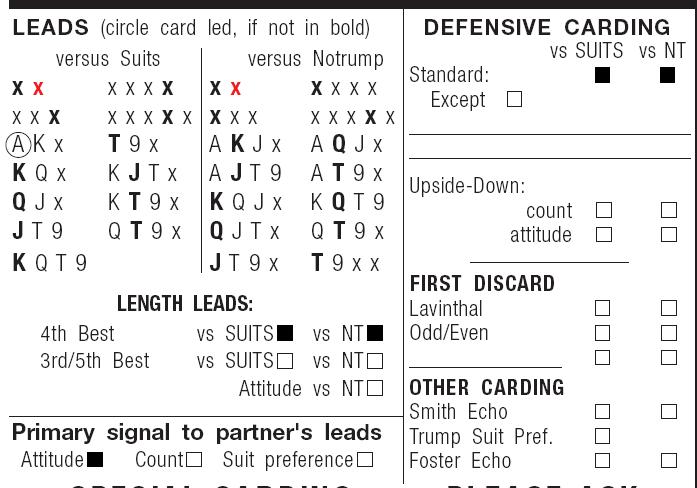

LC Standard is very simple here. For my Intermediate (and lower) students, I suggest 100% standard signals as marked. But, for more experienced players, I've spelled out some of the talking points below.
Leads are completely standard (including the now-normal A from AK versus suits). Fourth-best is led against notrump and against suits. Most experienced players will prefer to use 3rd/5th against suits instead. This means that from 4 (or 6) cards, the 3rd best card is led. From 3 or 5 cards, the lowest card is led. This all assumes the suit is headed by a 10 or higher. From a bunch of small cards there is no "normal/standard" option.
From xxx against suits, low is the "expert" choice, marked in bold, and part of LC Standard.
Against notrump, experienced players will want to agree on what is the "big lead." (What asks for count/unblock/attitude, etc.).
Defensive Carding
Signals of count are standard (hi-lo=2 or 4 or 6).
Signals of attitude are standard (hi=encouraging, lo=discouraging).
On partner's lead of a suit (if you can't beat dummy) give attitude.
On declarer's lead of a suit, give count if you think it is important.
When you discard, it is an attitude signal (followed by current count). Experienced players may wish to change and to use upside down (count or attitude or both) instead of standard.
Note: In many countries outside the U.S., what I refer to as standard is upside down -- and vice versa.
Another fun tool to add is odd-even discards.Smith Echo is not marked (but should be used by experienced players). It is used only against notrump. If we play hi-lo in the suit declarer first attacks, it means we like (relevant to the entire deal) the suit which our side led at trick one. Both defenders use Smith Echo. If count is deemed to be more important (dummy has a long suit with no entry), then that takes precedence.
Hi-lo in trumps means either you want a ruff, or you are trying to stress something in the highest suit.
This "outline" of carding is just to "get started." Experienced partnerships will need to discuss numerous situations and variations. A pair who plays LC Standard for just one day can likely get through every deal using the above carding agreements without having any misunderstandings. "Standard Carding" -- which is good enough for Bob Hamman, should be good enough for most players.
This concludes my series on LC Standard. It bears repeating: this is not a perfect system, but a system that can get you off the ground in a new partnership with a minimum of complex agreements and conventions. Give it a try and see how much easier bridge can be when you don't have to burden your memory with system!